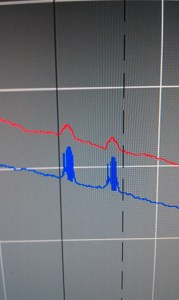Fiber optic testing with an OTDR is a fairly straight forward process. When you’re talking single-mode fiber most customers require, at a minimum, testing each fiber at 1310nm and 1550nm windows to insure that splice specifications are maintained. When testing outside plant this involves an OTDR , a pulse suppression box (launch) , knowledge of the network and the know-how to use the test equipment.
There are many, many man hours involved in testing and proofing fiber networks. Thus, it is important that time is well utilized and the data is collected properly. Although most OTDR’s manufactured today are very easy to use they don’t do the job for you. They are a tool to aid you in doing your job.

We were recently sent a pack of traces for review for one of our customers. There was an anomaly in the 1550nm window data that they could not explain and the contractor that did the work didn’t have any answer for them either. The contractor actually said the fiber was bad.
The anomaly (shown in the photo to the left) was caused due to the fact the OTDR being setup wrong by the technician. This particular OTDR has a macro event setting. It was turned on and for some strange reason the trace data had a false event imposed into the data. In all actuality there are no events at these points and the fiber cable was not damaged.
Tips when using an OTDR:
First, always use a launch cable. An OTDR pulses must traverse a minimum distance before the OTDR can take meaningful measurements. Always start with the OTDR set for the shortest pulse width for best resolution and a range at least 2 times the length of the cable you are testing. For fiber cable lengths of 18,ooo feet or less it is best to use a 500ns pulse width. Make an initial trace and see how you need to change the parameters to get better results.
At this point if things don’t look right re-check your settings, make sure all connectors are good and use your eyes to verify that the trace data you are collecting is clean of any anomalies.
A well trained technician knows that the OTDR is just a machine and the results it gives you are based on what you do when your collecting the trace data. If you’re un-trained or are not familiar with the problems that can arise when using an OTDR, the time you spend testing is all for not. If the data isn’t collected properly then the tech will be returning to the job to get the right information.
OLC Fiber is an industry leader in fiber testing, with a wide range of knowledge to inspect, verify, certify and troubleshoot any type fiber network. Click or call us today!
